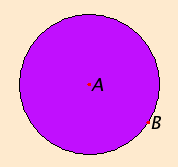Circles were defined in Def.I.15 and Def.I.16 as plane figures with the property that there is a certain point, called the center of the circle, such that all straight lines from the center to the boundary are equal. That is, all the radii are equal.
The given data are (1) a point A to be the center of the circle, (2) another point B to be on the circumference of the circle, and (3) a plane in which the two points lie. In the first few books of the Elements, there is but one plane under consideration and needn’t be mentioned, but in the last three books which develop solid geometry, the plane has to be specified.
